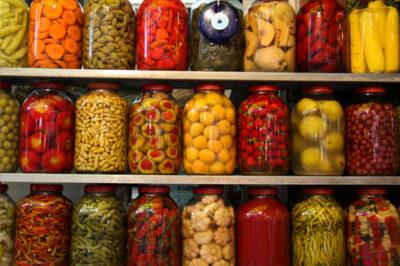The Time-Tested, Hidden Benefits Of Fermented Foods was originally published to http://totalsurvival.net
There are so many reasons why you should incorporate fermented foods into your diet.
Fermented foods: the words bring up images of sauerkraut and kimchi along with other pungent morsels. But if you haven’t given it much more thought than that, well, perhaps you should.
Fermentation is a great way to preserve food without the use of canning pots and freezers. It’s also loaded with additional benefits that other forms of preservation just don’t give you.
What Is Fermentation?
Fruits and vegetables naturally carry a beneficial bacteria known as lactobacilli. It’s one of the same types that you can find in cultured dairy products such as yogurt. Fermentation occurs when you submerge a fruit or vegetable in brine. After this, the lactobacilli will then begin to eat the natural sugar and essentially convert it into alcohol. Additionally, while the good bacteria are growing in number, they’re inhibiting putrefying bacteria that would otherwise cause the food to rot. The number of helpful bacteria will increase and they will produce enzymes. They will also produce other substances which have antibiotic and anti-carcinogenic properties.
Many cultures have employed this process since ancient times. The Ancient Greeks understood that an important chemical change took place during lacto-fermentation. They called it “alchemy.”
What Are The Benefits Of Fermented Food?
Perhaps the biggest benefit of consuming fermented food is its ability to boost your immune system. Scientists estimate that somewhere between 80-90 percent of your immune function happens in your gut. When “bad” bacteria overrun your intestines, you get sick. Adding a few spoonfuls of sauerkraut to your sandwich is like sending a small army of good bacteria to fight off the bad.
The bacteria from lacto-fermentation also helps to aid in digestion and may even help you to absorb certain nutrients more easily.
Finally, it is the only form of preservation that not only does not destroy certain nutrients, but it actually increases some. It is food that is high in digestive enzymes, B vitamins, omega 3s as well as lactase and lactic acid, which fend off harmful bacteria.
Story continues below video:
Furthermore, good health is not the only benefit – these foods are also incredibly easy on your pocketbook. Not only are fermented foods inexpensive, but you can make them very easily yourself. When you find that you’ve got more cabbage (or just about any other veggie) than your family is going to eat fresh, it’s a simple matter to ferment it yourself.
Purchasing Fermented Foods
While making fermented foods is an easy do-it-yourself project, there may be times when you’ll want to buy it from your local grocery store.
If you’re going to go for the store-bought variety, select something from the refrigerated section. Fermented food is full of living organisms that need to be kept cool in order to stay alive. Make sure the label does not say “pasteurized.” This would mean that those companies have heated and killed all those wonderful bacteria in their products.
Also, if purchasing a fermented soy product such as a miso, tempeh, or soy sauce, consider looking for one with an “organic” or “non-GMO verified” label. This is because soy is one of the worst offenders for being genetically modified.
Making Your Own Fermented Foods

If you’ve never made your own fermented foods before, it’s worth giving a try.
If you’ve never made your own fermented foods before, it’s worth giving a try. It is perhaps the easiest method of preservation and it does not require any special equipment. Beets, radishes, green beans, and onions all work well. But if this is your very first time, try starting out by making sauerkraut as it’s the easiest.
New “Survival Herb Bank” Gives You Access To God’s Amazing Medicine Chest
To make your own sauerkraut, simply wash and shred your cabbage and put it into a sealable container such as a mason jar. (Use a bigger one than you think you’ll need as it might bubble over during the fermentation process if you don’t). Now cover it with salt. That’s it! The salt will draw out the water in the cabbage and combine with it to form a brine. You may need to put some type of weight on the cabbage in order to keep it submerged.
Now keep your jar at a cool temperature – either in a cold cellar or in the refrigerator. The fermentation process will take about three days for a quart-sized jar. You’ll know when it’s ready by tasting it every couple of days. You’ll probably see some bubbles and a substance that looks like a white foam or scum. Nonetheless, this is normal and you can skim it off. If you expose any cabbage to the air it could get some mold, but this will not ruin the submerged cabbage in any way. Simply remove any moldy bits and enjoy your creation on a sausage, sandwich, or all on its own.
Conclusion
There are so many reasons why you should incorporate fermented foods into your diet. It’s healthy, inexpensive, and a great method of preservation. It’s also super easy to do yourself. Why not get started by making your own batch of sauerkraut today? From there, experiment with other vegetables and enjoy all of the benefits that these foods have to offer.
You may also enjoy reading an additional Off The Grid News article: Vinegar-Based Fruit Juices Ben Franklin Drank As Medicine On Hot Summer Days
What are your favorite fermented foods? Share them and any tips in the comments below.
Get $600 Worth Of Survival Blueprints … Absolutely Free!
The post The Time-Tested, Hidden Benefits Of Fermented Foods appeared first on Off The Grid News.
This Article Was Originally Posted On offthegridnews.com Read the Original Article hereRead More Here: The Time-Tested, Hidden Benefits Of Fermented Foods

No comments:
Post a Comment